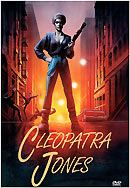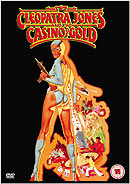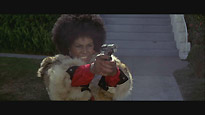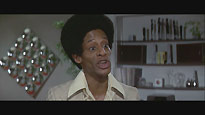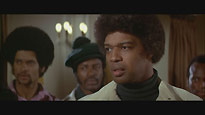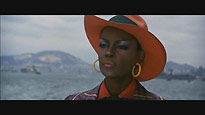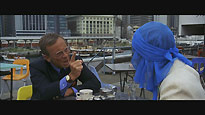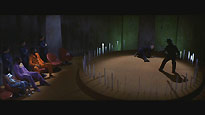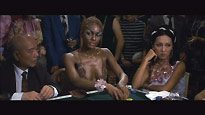|
CLEOPATRA JONES Director: Jack StarettFeaturing: Tamara Dobson, Shelley Winters, Bernie Caseyand CLEOPATRA JONES AND THE CASINO OF GOLD Director: Charles BailFeaturing: Tamara Dobson, Stella Stevens, Ni Tien, Norman FellRegion 2 Editions reviewed by Mark Frost THE FILMS Cleopatra Jones is a US special agent employed by the government to take on the mighty drug trafficking gangs who ply their wares on the streets of America. After Jones destroys a major Opium source, the head of a drug gang targets the government agent, her friends and associates. Cleopatra Jones must battle against rival gangs and her own crooked police force in order to strike a blow against the world’s evil drug industry.
CLEOPATRA JONES Afros? Check. Outrageous clothes? Check. Street slang? Check. This sounds like the ingredients for a good blaxploitation film. In this case, too good. As had previously be done with martial arts in Enter The Dragon, Warner Brothers seized upon a minor genre that was beginning to breakout and threw stacks of cash and technical know-how at it. For martial arts, this approach was just what the genre needed to kick-start it in new directions, for blaxploitation – it was everything the genre stood against, and the beginning of the end. The primary reason Cleopatra Jones does not work is the fact that that it ignores the main theme running through all earlier blaxploitation films – to give the black audience a chance to see a black hero stick it to the (white) man. The entire story of films such as Black Caesar and Superfly revolved around the protagonist getting rich off the white man in any way he could. The fact that this was often through crime only made the hero more fallible and human to the audience. Where Cleopatra Jones goes wrong is to have the hero work for ‘the man’, here as a special agent for the government. That’s not to say there were not honest heroes in other films of the genre – John Shaft (Shaft, 1971) was a law abiding policeman and Coffy (Coffy, 1973) was a nurse – but they certainly never let their employers get the better of them, or lose sight of the disadvantages that society dealt them. But Cleopatra Jones happily takes orders from her white superiors, with Warners even having the cheek to infer that it’s the government that deserves the credit for saving the day. It could be said that a story like this can not successfully be told by a white director, as it is here by Jack Starrett. To a certain extent I think this is true, but it cannot be ignored that one of the undeniable classics of the genre, Black Caesar, was directed by white exploitation supremo Larry Cohen. Another factor which sets Cleopatra Jones apart from other more ‘authentic’ blaxploitation films is the style. The influence of the big budget shows up in well framed, often technically ambitious shots – always well lit, always without faults. One of the defining features of blaxploitation, if not exploitation in general, is the rough, often experimental camera work. To me, the gritty handheld shooting and technical deficiencies of frenetic, visceral classics like Hell Up In Harlem and Cool Breeze, is exactly what the movement was all about – freedom to break the rules and do it another way. To see all of the widely accepted iconography of the genre on display, but presented in this professional and sterile manner, gives, at best, a lack of authenticity and, at worst, the feeling you are watching a spoof. The film is not entirely without merit though. The supporting cast is a sea of familiar faces from 1970’s cinema: Bill McKinney, hard-faced bad guy from countless movies including The Outlaw Josey Wales and The Parallax View; Paul Koslo – effective bit player who was superb in The Omega Man and many Charles Bronson films including Mr Majestyk; Albert Popwell, who managed to appear in the first four Dirty Harry movies as different characters without anybody noticing; and Antonio Fargus – infamous as Huggy Bear in Starsky and Hutch, but an important figure in the genesis of blaxploitation, having appeared in such stand-outs as Shaft and Foxy Brown. The headlining cast doesn’t fare as well. Tamara Dobson – an ex model – has little screen presence other than what is given to her by her extravagant outfits, leaving us wishing that someone of the caliber of blaxploitation queen Pam Grier had been cast instead. Getting Shelly Winters as the adversary must have seemed like quite a coup at the time, as she was still hot off the back of The Poseidon Adventure. Unfortunately, Winters uses this opportunity to deliver one of the worst performances I have ever witnessed. What was probably intended as a riotous tour de force instead turns out to be a noisy, irritating form of self-parody. Drawing on the performance she should have outgrown in Bloody Mama, Winters obviously believes she is appearing in something that is beneath her, so subsequently lets rip. A year later Nichelle Nichols, of Star Trek fame, showed Winters how it should be done in the underrated Truck Turner. The third lead, Bernie Casey, fares slightly better in the role of a drugs halfway house proprietor. He is required to act a lot of serious lines for such a lightweight movie, which he tries to instill with a bit too much dignity as if he were acting in a better film. That said, along with Fargus, Bernie Casey is the only actor to have actually earned his blaxploitation stripes in the likes of the splendid Get Carter remake Hit Man – and Cleopatra Jones benefits from his presence. The casual viewer will still find plenty to engage – motorbikes, kung fu fights, shootouts, car chases – but it all just feels like boxes ticked to me. This is blaxploitation as rich, white executives see it, and as such, should appear very low down your list.
CLEOPATRA JONES AND THE CASINO OF GOLD Cleopatra Jones and The Casino of Gold is, amazingly enough, actually a better film than the first. The flimsy story centres on the kidnapping of the Johnson Brothers (Albert Popwell and Caro Kenyatta returning from the first), by a ruthless Chinese drug gang. Cleopatra Jones is sent in to secure their release and bring the drug gang to its knees. This film seems more comfortable with itself than the preceding entry. There are no flamboyant characters, scenes or situations that spring from the need to remind us we are watching blaxploitation. Tamara Dobson gives a much-improved performance – more composed and confident, reminiscent of Faye Dunaway in The Thomas Crown Affair – and the lead villain (played by Shelly Winters’ co-star in The Poseidon Adventure, Stella Stevens) is far more effective and surprisingly mean and masochistic. As a stand-alone film it is instantly forgettable, a mish-mash of fights, car chases and other 70’s staples, with a poor narrative pace resulting in a very saggy middle. But viewed back to back with the original it shows itself to be a very watchable action piece, comparable to most similar films of the period. Even though the move to set the film in Hong Kong was probably cynical (Sir Run Run Shaw was producer), it adds to the appeal in terms of interesting locations and cultures on show – many unfamiliar in an American film. The latter half of the picture, which takes place in Macau, is a feast for the eyes - backed up by the impressive set design replicating the seedy gambling dens and glitzy casinos with equal success. The main reason to recommend this film is for the action set pieces – the motorbike scenes in particular. The production would seem to have used the local stuntmen rather than Westerners, as the stunts are superb. Certain shots reminded me of the early 80’s Asian work of Jackie Chan, where personal safety is never the most important factor. The final set piece in the Casino of Gold is an exhilarating display of stunt-work that really makes you sit up and take notice. With its handheld camerawork and furious inter-cutting – it more than makes up for the general malaise of what preceded.
THE DISCS Both films are presented in anamorphic 2:40-1 with generally pleasing pictures. Cleopatra Jones’ average bitrate is 5.94 Mb/s, and Cleopatra Jones and the Casino of Gold is 5.74 Mb/s, each on a single layer disc. Typical of Warner releases of this period, the image is sharp with good detail and contrast. My only main quibble is that the first film can be a little too dark at times. There are plenty of flecks dancing across the screen throughout, but that is as bad as it gets. Another solid title from Warner, who never seem to get enough credit for their DVD releases. The soundtracks are Dolby Digital mono (at 192kbps), as the films would have originally been presented. Yet again, no complaints as the track is very clear, with plenty of bass when needed. THE BONUS MATERIAL And here is where Warners get their usual telling off – no extras whatsoever. Are you telling me that Tamara Dobson, who hasn’t made a film since 1984, wouldn’t do a commentary for twenty quid? SUMMARY If you are looking for the definitive blaxploitation experience, then keep looking. The Cleopatra Jones films are the Hollywood version of blaxploitation, and thus are not really worth your time, rather best saved for stumbling back in from the pub with a couple of mates in tow in the mood for a giggle. It seems a shame that Warners couldn’t do the decent thing and put them as a double disc set for the regular price, ala Fox’s Our Man Flint and In Like Flint pairing, which would have resulted in a more favourable review. But if you’re a blaxploitation completist, then there is still plenty to enjoy in these well-presented discs.
|
|||||||||||||||||||||


